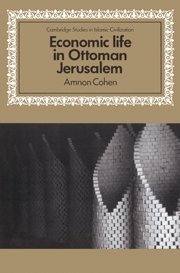Book contents
- Frontmatter
- Contents
- List of illustrations
- Note on transcription
- Map1
- Introduction
- 1 Butchers and meat consumption
- 2 Soap production and olive oil
- 3 Flour and bread
- Conclusion
- Note on abbreviations
- Note on weights, measures and monetary values
- Appendix 1 Meat prices in Jerusalem
- Appendix 2 Olive oil and soap prices in Jerusalem
- Appendix 3 Flour and bread prices in Jerusalem
- Appendix 4 A soap-factory in Jerusalem
- Notes
- Bibliography
- Subject index
- Geographical index
- Index of personal names
2 - Soap production and olive oil
Published online by Cambridge University Press: 10 November 2010
- Frontmatter
- Contents
- List of illustrations
- Note on transcription
- Map1
- Introduction
- 1 Butchers and meat consumption
- 2 Soap production and olive oil
- 3 Flour and bread
- Conclusion
- Note on abbreviations
- Note on weights, measures and monetary values
- Appendix 1 Meat prices in Jerusalem
- Appendix 2 Olive oil and soap prices in Jerusalem
- Appendix 3 Flour and bread prices in Jerusalem
- Appendix 4 A soap-factory in Jerusalem
- Notes
- Bibliography
- Subject index
- Geographical index
- Index of personal names
Summary
And the sons of Hārūn, may god bless him, used to come to the rock [in Jerusalem] and used to call it “the temple,” and a fountain of olive-oil poured down on them from heaven.
(Al-Wāsiṭī, Faḍā'il Bayt al-Maqdis)Braudel's distinction between “meat eaters” and “bread eaters” may be applied, although in somewhat attenuated form, to the realities of Ottoman Jerusalem. There was, however, a third element of equal importance in the daily diet of those days. This was, as may have been surmised from earlier textual references (see above, p. 56) as well as from acquaintance with Middle Eastern cuisine – olive-oil. In the economy of sixteenth-century Jerusalem, however, it also served as raw material for the production of soap, and in this chapter we shall elaborate on both uses of this commodity.
Soap-factories
When the Ottomans conquered Palestine the production of soap in Jerusalem was already a well established economic institution. Evidence from Mamluk times and even earlier indicates that olive oil extracted in the rural hinterland (particularly in the villages north of Jerusalem – bilād Banī Zayd – and jabal Nablus) was regularly brought into town. The local population used some of it; the rest served as raw material for soap, most of which was produced in Jerusalem itself.
In light of the general economic decline in Palestine during the late Mamluk period it would be reasonable to assume that soap production in Jerusalem was disrupted, as were other economic sectors.
- Type
- Chapter
- Information
- Economic Life in Ottoman Jerusalem , pp. 61 - 97Publisher: Cambridge University PressPrint publication year: 1989

